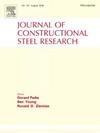Test-and-FE-based method for obtaining complete stress-strain curves of structural steels including fracture
IF 4
2区 工程技术
Q1 CONSTRUCTION & BUILDING TECHNOLOGY
引用次数: 0
Abstract
Ductile fracture is a common limit state of frameworks of steel structures and can be predicted by incorporating models for fracture initiation and propagation in finite element (FE) analyses. However, accurate prediction of fracture relies on unique fracture parameters for a given material, requiring precise predictions of fracture strain and stress states obtained through coupon tests and accompanying FE data analysis. In recent decades, various methods have been proposed to predict ductile fracture initiation, including various design geometries of coupons, test setups and FE analyses, which may lead to inconsistent fracture strains and stress states. Hence, there is a need for proposing a standard procedure for the design, test and accompanying FE-based calibration of fracture parameters, as pursued in this paper. Given that ductile fracture initiates under significant plastic strain, a constitutive model for the full strain range is required, as also proposed in this paper. Moreover, to reduce the experimental and data analytical efforts, an empirical method is proposed that uses only a small number of coupon tests to calibrate the fracture parameters. The method encompasses three levels wherein one, two, or three coupon tests are required. All in all, the paper presents a methodology for determining the full-range true stress-strain curve and the initiation of fracture, including a new post-necking constitutive model and methods for determining the free parameters of the post-necking and fracture initiation models. While applied to steel in this paper, the proposed methodology is potentially also applicable to other metals.
基于测试和 FE 的结构钢完整应力应变曲线(包括断裂)获取方法
韧性断裂是钢结构框架的常见极限状态,可以通过在有限元(FE)分析中加入断裂起始和扩展模型进行预测。然而,断裂的准确预测依赖于特定材料的独特断裂参数,需要通过试样测试和相应的有限元数据分析获得断裂应变和应力状态的精确预测。近几十年来,人们提出了各种预测韧性断裂起始的方法,包括各种试样设计几何形状、测试设置和 FE 分析,这些方法可能会导致断裂应变和应力状态不一致。因此,有必要提出一种标准程序,用于设计、测试和基于有限元分析的断裂参数校准,这也是本文所追求的目标。鉴于韧性断裂是在显著的塑性应变下发生的,因此需要一个全应变范围的构成模型,本文也提出了这一建议。此外,为了减少实验和数据分析工作,本文提出了一种经验方法,只使用少量的试样测试来校准断裂参数。该方法包括三个层次,分别需要进行一次、两次或三次试样测试。总之,本文提出了一种确定全范围真实应力-应变曲线和断裂起始的方法,包括一种新的缩颈后构成模型以及确定缩颈后和断裂起始模型自由参数的方法。本文所提出的方法适用于钢材,但也可能适用于其他金属。
本文章由计算机程序翻译,如有差异,请以英文原文为准。
求助全文
约1分钟内获得全文
求助全文
来源期刊

Journal of Constructional Steel Research
工程技术-工程:土木
CiteScore
7.90
自引率
19.50%
发文量
550
审稿时长
46 days
期刊介绍:
The Journal of Constructional Steel Research provides an international forum for the presentation and discussion of the latest developments in structural steel research and their applications. It is aimed not only at researchers but also at those likely to be most affected by research results, i.e. designers and fabricators. Original papers of a high standard dealing with all aspects of steel research including theoretical and experimental research on elements, assemblages, connection and material properties are considered for publication.
 求助内容:
求助内容: 应助结果提醒方式:
应助结果提醒方式:


